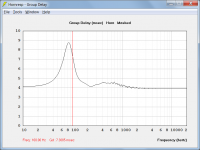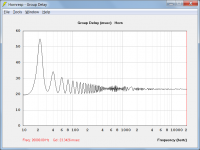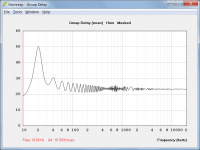After Windows update everything works fine
Thanks Entas, that is good to know!
What I still don't understand is why an update to Hornresp should have caused the problem in the first place. Nothing in the changes made should have affected the operation of the scroll bars.
I have 11 years worth of old installation files.
Mark, you really need to declutter
David can you please help me master the concept of group delay? the best impression I have yet is that Group delay is a measure of the amplitude envelope where the initial phase entry position represents 0ms....Thus....group delay in ms is the time it takes for the diaphragm to reach its peak amplitude.... you can respond here or join in on the discussion I started in the same fashion in my main thread.
here is just as good a place since, HornResp is where we monitor group delay in simulation.
here is just as good a place since, HornResp is where we monitor group delay in simulation.
Me- according to what I read it is....
So lets say it is not...
System a - 45hz GD 10ms
System b - 45hz GD is 100ms
What exactly measured 90ms longer ???
Martin King
Admin
System b has a higher Qts than system a, the slope of the phase curve is steeper in a higher Qts speaker, less damping of the SPL response which may produce a peak at tuning frequency. Nothing measures 90 ms longer. Group delay is defined as -(delta phase) / (delta frequency) which has units of (radians) / (radians/sec) simplifying to seconds. The units work out to seconds but there is no time domain involved in the calculations. In your example (delta phase) is 10 times steeper in system b than in system a at 45 Hz, that is all. It is an unfortunate name and misleading units.
Last edited:
David can you please help me master the concept of group delay?
I cannot really add to the information already provided in your main thread.
As far as Hornresp is concerned, group delay is the time delay of the signal through the loudspeaker as a function of frequency. In an ideal loudspeaker the phase would be linear and the group delay constant. In reality however, group delay distortions occur because signals at different frequencies take different amounts of time to pass through a practical loudspeaker. To illustrate - in the example attached, the time delay varies considerably across the frequency range, with the value at 100 hertz being 7.3085 milliseconds.
The key issue is at what point does group delay become audible...
EDIT:
A quick Google search found the following reference, which may be of some help in better understanding the concept:
What is Group Delay
Attachments
Last edited:
That is a very coherent explanation of group delay.
A few readings and a little thinking and pretty much anyone will be able to grasp what it is.
I need to pick your brain!
How relevant is it IRL? Can one hear the difference? Also, how does it affect the envelope of a sound burst as opposed to the effect on the shape of the waveform?That is a very coherent explanation of group delay.
A few readings and a little thinking and pretty much anyone will be able to grasp what it is.
I need to pick your brain!
Hah!
Finding it challenge number one!
How relevant is it IRL? Can one hear the difference? Also, how does it affect the envelope of a sound burst as opposed to the effect on the shape of the waveform?
I'll say it like this.
Sometimes and anecdote is the best way to understand problem and realities.
I designed a front loaded horn subwoofer years ago. Used a 12 inch driver. Has an Fc of 14 hertz and 8 meter length. Group delay was colossal. I brought it to the first ever DIY Ottawa meeting we have had regularly until it got COVIDeded, ed.
A few of the guys I met were very knowledgeable in acoustics and all things Audio. I showed him the simulations and the interior pics of the build. Dave told me that group delay is indeed audible. And that he had written a paper on it. I asked under what conditions? ( I have been reading papers since the late 80's ) The answer was sine waves on close fitting headphones. I asked how easily masked was the effect? Gone under musical conditions.
So I set up the demonstration Using a Philips recording of Saint Saens 3rd symphony and a well recorded pipe organ San Francisco symphony Edo de Waart and Jean Guillou at the console. I explained that they would be hearing a true 16 hertz tone. All explained to me that you canna hear below 20 hertz. That was up until a low C at 32 foot pitch was played and the collective jaw drop and what the F...
So can you hear Group delay? Not really.
But is it accompanied by other forms of distortion in different systems? Yes. Group delay can also have it's buddy intermodulation distortion. I readily hear it in Passive radiator systems and anything that uses a resonance in the system to fill in twin peaks. Band pass enclosures. Tapped horns.
Is this group delay? No. Group delay is in those same said systems. But it is not what you are hearing.
Dave has since been a great friend and brain I pick on from time to time. And the rest of the guys have never forgotten their experience either. It was fun.
And that is what got me into audio in the first place. I played French Horn very well. And I wanted something to listen to that could reproduce what I heard and sat amongst. Music and it's enjoyment.
THis is what pisses me off
I guess Ill eventually get banned form his group because if you guys notice....I never "drop it"
Martin King
Group Delay is a very poor title, it does not indicate any kind of time delay, it is only the derivative of the changing phase...
I guess Ill eventually get banned form his group because if you guys notice....I never "drop it"
Last edited:
And it's something that we all have to live with.
Phase, My pet peeve. Is the place of a pressure front ( all sound is a pressure difference to the surrounding atmosphere right?) or signal measured in time from a certain point, either it's start or part way through it's creation or propagation. And it is described in degrees in 3 dimensions. But how often is it described properly? When we look at a sign wave, we see it in two dimensions. It is literally a side on view of a corkscrew.
Crusade over.
We have to live with it. Learn about it. And deal with it. Just like on the YouTube hydraulic channel. Now we must deal with it!
Phase, My pet peeve. Is the place of a pressure front ( all sound is a pressure difference to the surrounding atmosphere right?) or signal measured in time from a certain point, either it's start or part way through it's creation or propagation. And it is described in degrees in 3 dimensions. But how often is it described properly? When we look at a sign wave, we see it in two dimensions. It is literally a side on view of a corkscrew.
Crusade over.
We have to live with it. Learn about it. And deal with it. Just like on the YouTube hydraulic channel. Now we must deal with it!
Thanks Entas, that is good to know!
What I still don't understand is why an update to Hornresp should have caused the problem in the first place. Nothing in the changes made should have affected the operation of the scroll bars.
Same happened for me. Took 2 days to update windows. Once it did, the sliders all returned. Very strange indeed! Program worked fine. I was on a version from maybe, 6-8 months ago. Opened hornresp and it said updates available. At first i ignored it figuring it was just the paraflex updates. Finally updated, overwriting the .exe and .dll files, and poof the sliders were gone. Not sure exactly what happened, but happy to report im once again modeling.
Thanks for your help David, and tremendous support to the audio community!
And it's something that we all have to live with.
Phase, My pet peeve. Is the place of a pressure front ( all sound is a pressure difference to the surrounding atmosphere right?....
Beautiful
Group delay can also have it's buddy intermodulation distortion. I readily hear it in Passive radiator systems and anything that uses a resonance in the system to fill in twin peaks. Band pass enclosures. Tapped horns.
Um, front loaded horns are basically bandpass enclosures
Badly-designed bandpass enclosures tend to have high out of band resonance peaks, which might be what you're hearing. And tapped horns are basically bandpass enclosures with high out of band resonance peaks, so....
I can hear it...its not something the average person can pick out...it needs to be rather high in the region where I hear it and must be able to a/b material between the system in question and headphones... it becomes a critical issue for me in the tuning of compression on bass...it makes the bass sound as if it has a compressor on it with a quick release....it also affects perception of the attack envelope in particular an issue with tweaking the attack envelope of a compressor or electric bass instruments.... as a musician and sound engineer I am sensitive to time based distortion....but I have only claimed to hear it in bass...a my current subs are vented with no dampening material which is a classic case for high group delay around tuning. It sounds as a late arrival of lower bass signal in my system...I can pick it out of the play back of various bass drums.
A front loaded horn tuned to 14hz doesn't have group delay issues lol...not to mention that the lower the note the higher group delay has to be for its perception...tuned to 14hz group delay of your horn was like that of a sealed above tuning....that is in comparison to the rest of the spectrum vs tuning where group delay peaks
A front loaded horn tuned to 14hz doesn't have group delay issues lol...not to mention that the lower the note the higher group delay has to be for its perception...tuned to 14hz group delay of your horn was like that of a sealed above tuning....that is in comparison to the rest of the spectrum vs tuning where group delay peaks
Last edited:
happy to report im once again modeling.
That is great news resko1! Thanks for letting me know that everything is now working again - I was getting a bit worried there for a while...
Has an Fc of 14 hertz and 8 meter length. Group delay was colossal.
The attachments show the predicted group delay results for a representative 14 Hz exponential horn of length 8 metres. At 20KHz the signal delay is almost entirely due to the time it takes for the sound to travel through the horn. At high frequencies the delay through the drive unit itself is relatively small.
At 20KHz:
Predicted signal delay = 23.3426 milliseconds
Horn length = 8 metres
Velocity of sound = 344 metres per second
Delay through horn = 8 / 344 * 1000 = 23.2558 milliseconds
Delay through driver = 23.3426 - 23.2558 = 0.0868 milliseconds
It is interesting to note that at 10Hz the signal through the system is delayed by 18.7659 milliseconds, meaning that for the chosen example at least, at that frequency the delay through the driver has a negative value of 18.7659 - 23.2558 = -4.4899 milliseconds.
Attachments
- Home
- Loudspeakers
- Subwoofers
- Hornresp


